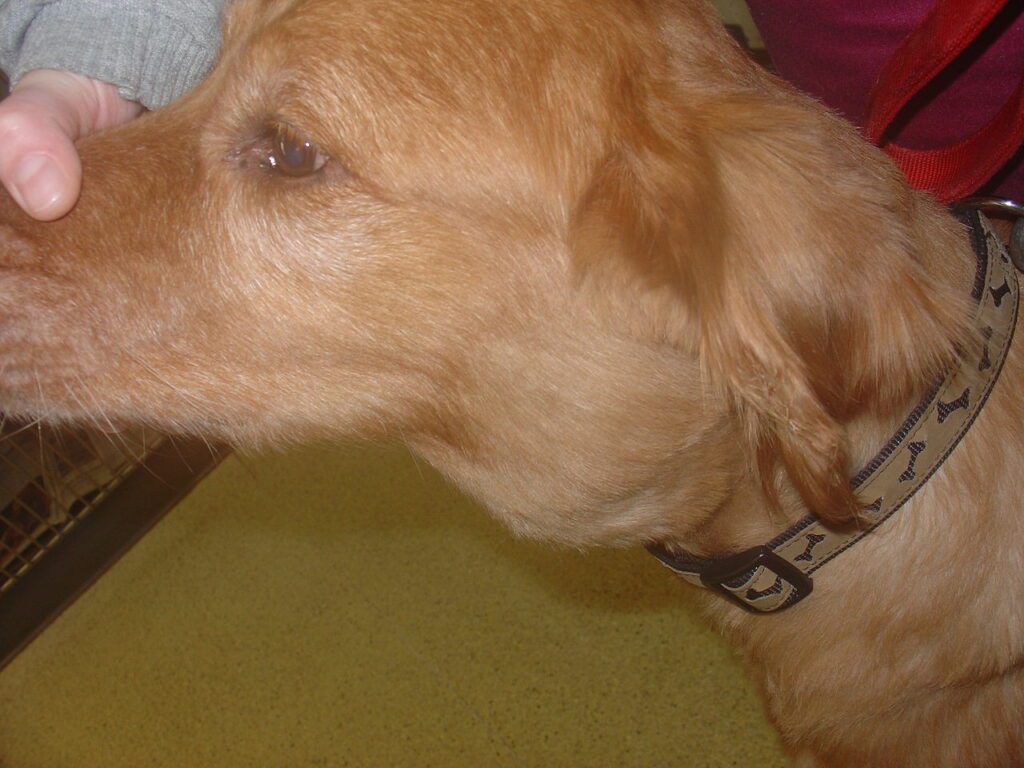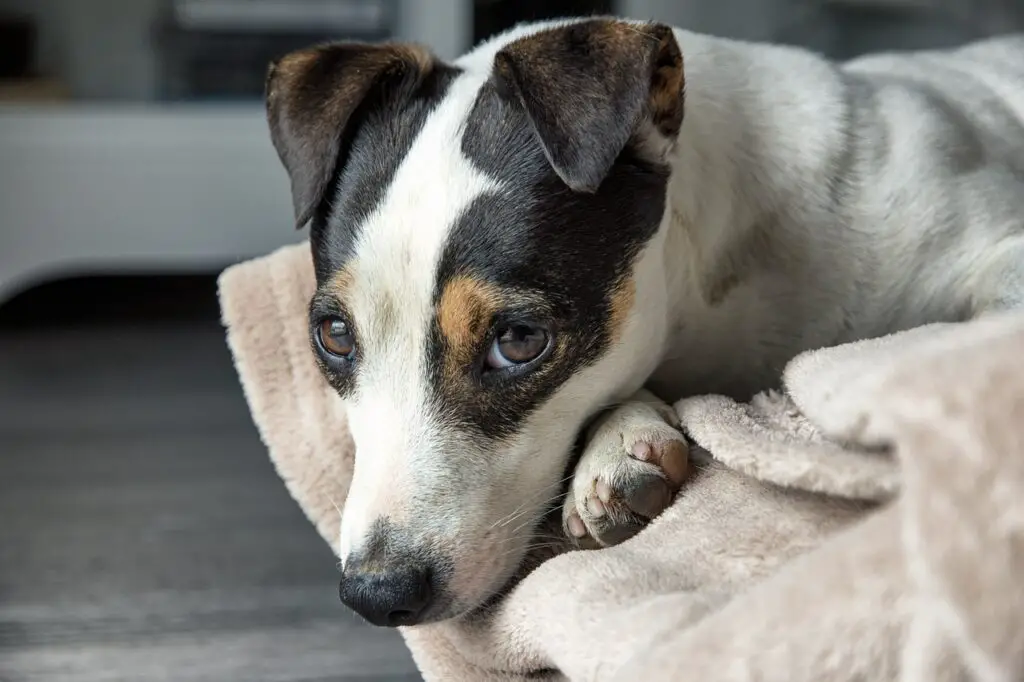This informative guide is designed with pet owners in mind, providing a step-by-step process to conduct a basic health examination at home.
Lymph nodes are crucial parts of the dog’s immune system, and changes in their size or texture can be an early indicator of health issues.
In this blog post, we will help you understand where these lymph nodes are located and how to gently check them, allowing you to monitor your furry friend’s health more effectively.
- Key Takeaway
- What Are Dog Lymph Nodes?
- How To Check a Dog’s Lymph Nodes
- What Causes Swollen Lymph Nodes In Dogs?
- Symptoms Of Swollen Lymph Nodes In Dogs?
- Where Are Dog Lymph Nodes Located?
- FAQs
- Q: What are the causes of swollen lymph nodes in dogs?
- Q: How can I determine if my dog has swollen lymph nodes?
- Q: What is lymphoma in dogs?
- Q: How can a lymph node biopsy help in diagnosing lymphoma?
- Q: What is the prognosis for dogs with lymphoma?
- Q: What are the treatment options for dogs with swollen lymph nodes?
- Q: Should I consult a veterinarian if my dog has swollen lymph nodes?
- Q: Can pet owners do anything at home to help relieve swollen lymph nodes in dogs?
- Q: Are lymph nodes the only areas that can become enlarged in dogs?
- Q: Can pet insurance cover the cost of lymph node biopsy and treatment?
- In Conclusion
Key Takeaway
- To check a dog’s lymph nodes, you gently palpate or feel the areas where the nodes are located – under the jaw, at the front of the shoulders, on either side of the windpipe below the jawline, in the groin region, and at the back of the knees – for any swelling or abnormalities.
- Dog lymph nodes are small, bean-shaped glands that form an essential part of the immune system, helping to filter harmful substances and fight off infections.
- Dogs have numerous lymph nodes located throughout their body, with five sets of peripheral lymph nodes that are easily palpable: submandibular (beneath the jaw area), prescapular (lower neck, near the chest), axillary (armpit), inguinal/femoral (inner thigh), and popliteal (behind the knees).
What Are Dog Lymph Nodes?

Dog lymph nodes are an integral part of a dog’s immune system.
They are small glands located in various parts of the body, such as under the jaw, between the shoulder and the neck, under the front legs, and in the inguinal region of the back legs.
These nodes house lymphocytes that process antigens for antibody production and help fight against infections.
The lymph nodes can become swollen due to various reasons including bacterial, viral, fungal, or parasitic infections, inflammation, allergies, or even cancer-like lymphoma.
Swollen lymph nodes in dogs might appear as firm, rubbery lumps that move freely beneath the skin and are typically not painful.
See also: Can Dogs Live Without Lymph Nodes?
How To Check a Dog’s Lymph Nodes

- Identify the location of the lymph nodes in your dog.
- Use a gentle touch to feel the area.
- Check for any swelling or lumps.
- Take note of any changes in size or consistency over time.
- Look for other signs of illness in your dog such as loss of appetite, lethargy, or changes in behavior.
- If you find any abnormalities or if your dog shows signs of illness, take them to a veterinarian for further examination.
Identify the Location of the Lymph Nodes in Your Dog
The first step is to know where to look. The most commonly checked lymph nodes in dogs are located under the jaw, in front of the shoulders, and behind the knees.
Use a Gentle Touch to Feel the Area
Once you’ve identified the location of the lymph nodes, gently feel them with your fingers. Remember, lymph nodes are usually round and move slightly when touched.
Check for Any Swelling or Lumps
Normal dog lymph nodes are small and may not be noticeable. If they’re swollen, they can be the size of a bean or larger. So, it’s important to check for any unusual swelling or lumps.
Take Note of Any Changes in Size or Consistency Over Time
Regular checks can help you notice any changes quickly. If you find that the lymph nodes have changed in size or consistency, it could indicate a health issue.
Look for Other Signs of Illness in Your Dog
In addition to checking the lymph nodes, observe your dog for other signs of illness such as loss of appetite, lethargy, or changes in behavior.
If You Find Any Abnormalities, Take Your Dog to a Veterinarian
If you discover any abnormalities during your check or if your dog is showing signs of illness, it’s crucial to take them to a veterinarian for further examination. This will ensure that any potential health issues are addressed promptly.
See also: Can Dog Lymph Nodes Be Removed?
What Causes Swollen Lymph Nodes In Dogs?
- Infections: One of the most common causes of swollen lymph nodes in dogs is due to an infection within the body. This could be bacterial, fungal, or parasitic infections. Infections may even be within the lymph node itself.
- Diseases: Certain diseases such as demodectic mange, puppy “strangles” (i.e., juvenile cellulitis), and tick-borne diseases (e.g., Lyme disease) can also lead to swollen lymph nodes.
- Lymphoma: Lymphoma, a type of cancer, is the most common reason for enlarged lymph nodes. There are over 30 types of lymphoma in dogs.
- Local Respiratory Infections or Dental Disease: These can cause the submandibular lymph nodes to enlarge.
See also: Can Dogs Lymph Nodes Swell From Allergies?
Symptoms Of Swollen Lymph Nodes In Dogs?
- Noticeable enlargement of the lymph nodes
- Loss of appetite or unexplained weight loss
- Lethargy or decreased activity levels
- Fever
- Difficulty breathing or swallowing (if the swollen nodes are in the chest or neck)
- Persistent itching or skin infections
- Swelling in the limbs (if the lymph nodes in the legs are affected)
- Changes in behavior or mood
See also: 9 Causes Of Swollen Lymph Nodes In Dogs
Where Are Dog Lymph Nodes Located?
Dog lymph nodes are located in several areas throughout their body. Here are the primary locations:
- Submandibular lymph nodes: These are found under your dog’s jaw, though they can easily be confused with the larger salivary glands that produce saliva.
- Pre-scapular lymph nodes: These are located under the submandibular lymph nodes at the front of the shoulders.
- Neck lymph nodes: These can be felt on either side of the windpipe, just below the jawline.
- Inguinal lymph nodes: These are located in the groin region.
- Popliteal lymph nodes: These are found at the back of the stifle (i.e., knee).
- Cervical nodes: These are located under the back of the jaw.
FAQs
Q: What are the causes of swollen lymph nodes in dogs?
A: Swollen lymph nodes in dogs can be caused by various factors such as infections, inflammation, allergies, immune system disorders, and even cancer.
Q: How can I determine if my dog has swollen lymph nodes?
A: You can check for swollen lymph nodes in your dog by carefully feeling the lymph nodes regions, such as the neck, armpits, and groin area. If you notice any abnormal enlargement or lumps, it’s best to consult a veterinarian.
Q: What is lymphoma in dogs?
A: Lymphoma in dogs is a type of cancer that affects the lymphatic system, which is a part of the immune system. It can occur in different parts of the body and can cause lymph node enlargement.
Q: How can a lymph node biopsy help in diagnosing lymphoma?
A: A lymph node biopsy involves the removal of a small sample of tissue from the affected lymph node. This sample is then examined under a microscope to determine the presence of abnormal cells, which can help diagnose lymphoma or other conditions.
Q: What is the prognosis for dogs with lymphoma?
A: The prognosis for dogs with lymphoma can vary depending on various factors such as the stage of the disease, the type of lymphoma, and the overall health of the dog. Some dogs may experience long-term remission with appropriate treatment, while others may have a shorter life expectancy.
Q: What are the treatment options for dogs with swollen lymph nodes?
A: The treatment options for dogs with swollen lymph nodes can include medication to manage symptoms, antibiotics if there is an infection, chemotherapy for lymphoma cases, and sometimes surgical intervention if necessary.
Q: Should I consult a veterinarian if my dog has swollen lymph nodes?
A: Yes, it’s important to consult a veterinarian if your dog has swollen lymph nodes. They will be able to evaluate your dog’s condition, perform necessary tests, and recommend appropriate treatment options.
Q: Can pet owners do anything at home to help relieve swollen lymph nodes in dogs?
A: While home remedies may not directly address the underlying cause of swollen lymph nodes, providing a calm and comfortable environment for your dog can help support their overall well-being. It’s best to follow your veterinarian’s advice regarding any home care.
Q: Are lymph nodes the only areas that can become enlarged in dogs?
A: No, lymph nodes are not the only areas that can become enlarged in dogs. Other glands or organs, such as the spleen, liver, or even certain types of tumors, can also cause enlargement.
Q: Can pet insurance cover the cost of lymph node biopsy and treatment?
A: The coverage of lymph node biopsy and treatment may vary depending on the pet insurance provider and the specific policy. It’s best to consult your pet insurance company to understand the extent of coverage for such procedures.
See also: Where Are Dog Lymph Nodes Located?
In Conclusion
In conclusion, checking a dog’s lymph nodes is an important part of their overall health care.
By performing regular checks and being mindful of any changes in the size or texture of the nodes, pet owners can identify potential issues early on and make sure that their pup stays happy and healthy.





Leave a Reply